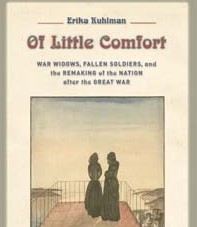Book Review: Of Little Comfort: War Widows, Fallen Soldiers, and the Remaking of the Nation after the Great War
Author: Erika Kuhlman
Publisher: New York University Press; 223 pages
Book Review by: Paiso Jamakar
This book is about German and American widows of World War I. The author used numerous primary sources to get material for this book.
A description of the thesis of this book on the back cover states that “each nation used widows and war dead as symbols to either uphold their victory or disengage fro their defeat, but Kuhlman, parsing both German and U.S. primary sources, compares widows’ lived experiences to public memory.”
This book by Erika Kulhman has been critiqued as “a pathbreaking study,” an “extremely original study,” an “insightful and well-researched study” and a “new model of scholarly analysis.”
She is associate professor of history at Idaho State University. She is the author of Petticoats and White Feathers, Reconstructing Patriarchy after the Great War and a volume co-edited with Kimberly Jensen titled Women and Transnational Activism in Historical Perspective. She is the editor of Peace & Change: A Journal of Peace Research.
In a book of just five chapters with about 160 pages of discussion but backed up with more than 60 pages of notes and lists of reference works, the author successfully documents many personal experiences during and after World War I among the millions of black-clad widows so frequently seen in Europe’s cities.
The author compares the ways in which German and American widows experienced their postwar status. She relates how their experiences “played into the cultures of mourning into their two nations: one defeated, the other victorious.”
The impact of the First World War was huge. The author writes in the first chapter than some nine million uniformed men were killed. Of those, about three million were married. In Germany, the loss was greatest. Some 1.8 million German soldiers died in that war. Nearly one third were married, resulting in 600,000 widows.
In France also, some 600,000 wives wore black. In England and Italy, the figure stood at around 200,000 each. In the United States however, the number of widows was just about 33,000.
In the Second World War – which began just 20 years after peace treaty ending the earlier conflict was signed – some 300,000 U.S. military personnel lost their lives and about 83,500 widows survived them. Kulhman writes the “feelings of grief and despair over losing one’s life partner had not changed much, either.”
The central theme of this book is the absurdity of war for the victorious and the defeated nation, and therefore the need to end war forever. Towards that end, the author has done an admirable job, documenting all the details.







